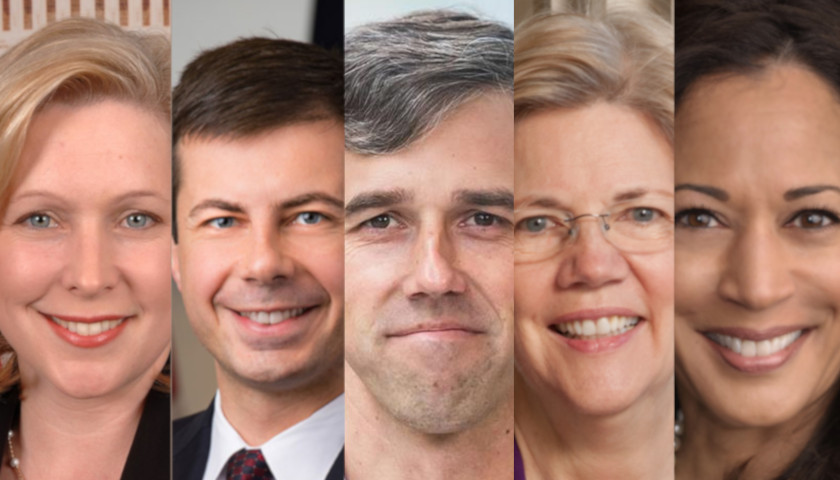by Kevin Daley
A growing number of Democratic presidential candidates are entertaining a push to add seats to the Supreme Court, as Republican success at filling the courts with judicial conservatives has infuriated progressive voters.
Democratic presidential candidates Kamala Harris, Elizabeth Warren, Robert “Beto” O’Rourke, Pete Buttigieg, and Kirsten Gillibrand have expressed willingness to consider proposals for expanding the composition of the Supreme Court as of this writing.
The Trump campaign charged that those suggestions, called court-packing, keeps with other structural reforms to the U.S. political system some Democrats have endorsed since the 2016 election.
“This is just what the Democrats always do,” the Trump campaign told TheDCNF. “When they lose, they try to change the rules. This is no different from when they attack the Electoral College every time they lose the White House. Now it’s court-packing. They want to change our institutions to fit their own political desires.”
Another presidential candidate, Democratic Sen. Cory Booker of New Jersey, advanced a more modest proposition. Speaking Monday night on MSNBC, the senator said term limits for Supreme Court justices might be appropriate, but he seemed reluctant to endorse expansion of the Court.
Democrats frame the issue as a credibility problem. By their telling, the campaign began when Senate Majority Leader Mitch McConnell refused to fill the vacancy occasioned by Justice Antonin Scalia’s death until after the 2016 election, and continued apace with the abolition of the filibuster for high court nominees.
“We are on the verge of a crisis of confidence in the Supreme Court,” Harris told Politico. “We have to take this challenge head on, and everything is on the table to do that.”
O’Rourke struck a similar note Friday at a Burlington, Iowa coffee shop, telling onlookers that an expanded Court is “an idea that we should explore” to curb partisanship and political dysfunction. The former El Paso congressman floated a proposal to add six justices to the high court. Under that system, Democrats and Republicans would each appoint five justices. Those ten would then unanimously select the remaining five.
Other procedural changes for lower court nominations have inflamed Democratic anger, such that packing the courts — once thought radical — is now a viable political position.
“The GOP has also undermined virtually all of the customs that protected the minority and home state senators in the judicial selection process, such as White House consultation and blue slips, while ramming through circuit nominees with little process,” Carl Tobias, a law professor at the University of Richmond, told The Daily Caller News Foundation.
After President Donald Trump took office, the Republican-controlled Senate Judiciary Committee began holding confirmation hearings in which multiple circuit court nominees appear for testimony. Democrats say that’s a break with historical practice.
The committee has also effectively abandoned the minority party’s blue slip veto for appeals court nominations, which allows senators to block nominees tapped for judgeships in their state. Republicans say the blue slip process has not been consistently observed for circuit court confirmations and makes little sense for appellate nominees.
Interest in court-packing has also waxed due to a sustained interest group campaign. Career Democratic operatives, attempting to put liberal interest in the judiciary at parity with conservatives, founded a dark money political group that is urging Democratic candidates to endorse court-expansion ideas.
A Democratic Court-packing bid would likely require a filibuster-proof majority in the Senate. Given that daunting prospect, a near-term effort to expand the Court is unlikely to succeed. Yet the Democratic flirtation with court-packing might itself bring the justices to heel. Tobias suggested that a threat to the institution’s composition, even if unlikely, could deter the justices from moving the law rightward.
“Discussing that prospect and other proposals like term limits for justices or adding lower court judges may signal to the Court that it should not veer sharply to the right, as Chief Justice John Roberts seemed to be signaling to Trump and the nation with his rebuff of Trump regarding ‘Obama judges,’” Tobias said, referencing an episode in 2018 in which Roberts rebuked Trump for deriding a district court judge who enjoined the administration’s asylum reforms.
Carrie Severino, chief counsel for the Judicial Crisis Network, accused Democrats of browbeating the Court’s newly entrenched conservative majority.
“Democrats will try anything to politicize the judicial selection process and the courts,” Severino told TheDCNF. “Now they are trying to bully and intimidate the Supreme Court’s justices into serving as a rubber stamp for a liberal political agenda.”
Popular history holds that a similar tactic animated an important change on the Supreme Court during the 1930s. A conservative coalition on the high court struck down much of President Franklin Roosevelt’s domestic economic program during his first term. Flush with victory after his landslide reelection in 1936, Roosevelt asked Congress for authority to appoint as many as six new justices.
Though the Democratic Congress overwhelmingly repudiated that request, Justice Owen Roberts, then the “swing vote” on the bench, began voting to uphold progressive economic measures, like the constitutionality of minimum wage laws. That shift was widely interpreted as a strategic move to protect the Court from Roosevelt’s scheme. Recent scholarship questions the accuracy of this view, sometimes called “the switch in time that saved nine.”
Still, Roosevelt’s plot is widely seen as notorious and misguided, and may explain why no candidate has yet given a court-packing alternative their unqualified endorsement. Instead, the Democratic 2020 contenders urge further discussions or decline to rule out the possibility.
– – –
Kevin Daley is a reporter for the Daily Caller News Foundation. Follow Kevin on Twitter.
Photo “Beto O’Rourke” by Beto O’Rourke. Photo “Pete Buttigieg” by Pete Buttigieg.




